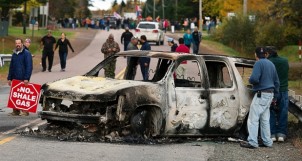
By Amanda Blank
In many communities sitting on top of shale gas reserves, initial enthusiasm over domestic drilling is quickly transformed into inflamed opposition from citizens and officials who express health, safety and environmental concerns. Because fracking is a relatively new technology being used for the first time in many localities, it rarely comes without contention.
Municipalities, states, and federal governments are faced with regulating natural gas drilling, and there are no scripts or models that demonstrate how to do this well (or if it is even possible to do it well). Two recent stories in the news highlight how hot local resistance to fracking can get when governments try to steamroll exploration of shale gas despite community opposition.
Canada is at the forefront of the international fracking boom, with only the United States leading in shale gas development. As is the case with countless environmental disputes, indigenous people are among the most heavily impacted populations. At the very heart of the fracking unrest are dysfunctional treaty relations and hasty exploitation of land. While fracking expands through the Canadian provinces, protests are also escalating. The Mi’kmaq people in New Brunswick have been peacefully protesting and protecting their land by holding a road blockade since the summer. They are demanding that national treaties (theoretically) including them in an equitable decision making process be upheld. Sadly, the peaceful protests turned into a spectacle of state police repression in mid-October, when a “small army of para-military-like authorities” from the RCMP snuck up on a line of tents where Mi’kmaq elders, children, and others had been camped in an attempt to protect their land. The invasion turned violent, with rubber bullets fired and police cars ablaze, harking back to stand-offs between the police and indigenous populations such as the Oka Crisis. What prompted the invasion of the peaceful protests, and, as the Mi’kmaq people are now asking—what now? It is unlikely that the Harper government will uphold treaties with indigenous people as demanded, while the Elsipogtog First Nation and other affected communities also seem unlikely to back down.
Meanwhile in Europe, Chevron was approved in 2013 to drill exploratory wells in the particularly impoverished region of Vaslui, Romania, along with three other areas in the Black Sea. The first well was planned to be functional by the end of the year. However, over the past few months, thousands of Romanians have been protesting government backing for shale gas exploration because of its potential disastrous consequences for communities. In reaction to the public outcry, Chevron agreed in mid-October to suspend its exploratory activities. There will be a local referendum held on Nov. 24, where the community will decide whether or not they will allow further shale gas exploration. Chevron claims, “[We are] committed to building constructive and positive relationships with the communities where we operate and we will continue our dialogue with the public, local communities and authorities on our projects.” As Chevron has already secured all the necessary permits it needs to continue work, the decision made by the local referendum will not be legally binding. Is it possible that Chevron will refrain entirely from natural gas extraction in Vaslui if the community’s final answer is against gas exploration? If Chevron recedes, what distinguishes this case from countless unsuccessful community protests, and what can be learned from it?
“Fracktivism” is often framed not as defense of the environment per se, but rather, communities speak about defense of their territories and their communities – including their culture, community health, and of course, the land and water people depend upon for survival. For many rural and middle class families, it is the first time they are confronted with fossil fuel extraction taking place literally in their backyards, and fracking activism has thus has become an important tool for mobilizing communities, and educating them about energy issues and climate justice. Yet, against this backdrop, dwindling energy supplies means that energy self-sufficiency remains a high priority for many governments, despite the high local social and economic costs, and opposition be damned.
At the very least, uniform regulatory protection must be developed to reduce the negative consequences and to include communities in decision-making processes. At best, natural gas exploitation needs to be drastically limited. Regardless, it should not be seen as our savior in the energy crisis.
How many protests, how much polluted water, how many destroyed communities, how many environmental justice errors—will it take before concrete, protective management changes the free-for-all world of fracking?
Photo from: http://sacredfirenb.com/tag/elsipogtog/



Thanks for the article that disseminates information about protests in Romania, as well. In spite of the assuarances about safety, who can guarantee that technology does not collapse and human workforce does not fail to provide safety?